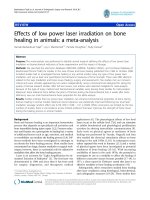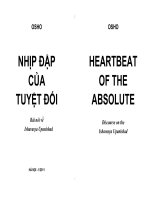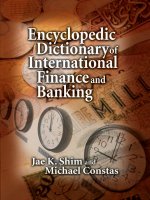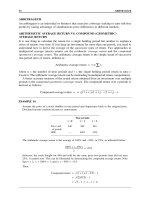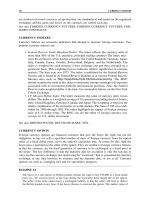Encyclopedic Dictionary of International Finance and Banking Phần 1 pdf
Bạn đang xem bản rút gọn của tài liệu. Xem và tải ngay bản đầy đủ của tài liệu tại đây (723.79 KB, 34 trang )
St. Lucie Press
Boca Raton London New York Washington, D.C.
Encyclopedic
Dictionary
of
International
Finance
and
Banking
Jae K. Shim
Michael Constas
St. Lucie Press
Boca Raton London New York Washington, D.C.
Encyclopedic
Dictionary
of
International
Finance
and
Banking
Jae K. Shim
Michael Constas
This book contains information obtained from authentic and highly regarded sources. Reprinted material is quoted with
permission, and sources are indicated. A wide variety of references are listed. Reasonable efforts have been made to publish
reliable data and information, but the author and the publisher cannot assume responsibility for the validity of all materials
or for the consequences of their use.
Neither this book nor any part may be reproduced or transmitted in any form or by any means, electronic or mechanical,
including photocopying, microfilming, and recording, or by any information storage or retrieval system, without prior
permission in writing from the publisher.
The consent of CRC Press LLC does not extend to copying for general distribution, for promotion, for creating new works,
or for resale. Specific permission must be obtained in writing from CRC Press LLC for such copying.
Direct all inquiries to CRC Press LLC, 2000 N.W. Corporate Blvd., Boca Raton, Florida 33431.
Trademark Notice:
Product or corporate names may be trademarks or registered trademarks, and are used only for
identification and explanation, without intent to infringe.
Visit the CRC Press Web site at www.crcpress.com
© 2001 by CRC Press LLC
St. Lucie Press is an imprint of CRC Press LLC
No claim to original U.S. Government works
International Standard Book Number 1-57444-291-0
Library of Congress Card Number 2001001297
Printed in the United States of America 1 2 3 4 5 6 7 8 9 0
Printed on acid-free paper
Library of Congress Cataloging-in-Publication Data
Shim, Jae K.
Encyclopedic dictionary of international finance and banking / Jae
K. Shim and Michael Constas.
p. cm.
ISBN 1-57444-291-0 (alk. paper)
1. International finance—Encyclopedias. 2. Banks and banking,
International—Encylopedias. 3. International economic
relations—Encyclopedias. I. Constas, Michael, 1952- . II. Title.
HG3880 .S55 2001
332
′
.042
′
068—dc21 2001001297
disclaimer Page 1 Tuesday, May 15, 2001 3:54 PM
P
REFACE
WHAT THIS BOOK WILL DO FOR YOU
The
Encyclopedic Dictionary of International Finance and
Banking
is written and compiled
for working professionals engaged in the fields of international finance, global trade, foreign
investments, and banking. It may be used for day-to-day practice and for technical research.
The
Encyclopedic Dictionary
is a practical reference of proven techniques, strategies, and
approaches that are successfully used by professionals to diagnose multinational finance and
banking problems. The book covers virtually all important topics dealing with multinational
business finance, investments, financial planning, financial economics, and banking. It also
covers such topics as computers, quantitative techniques and models, and economics as
applied to international finance and banking. The
Encyclopedic Dictionary
will benefit prac-
ticing financial analysts, CFOs, controllers, financial managers, treasurers, money managers,
fund managers, investment analysts, and professional bankers, among others.
The subjects are explained with
• Clear definitions and explanations, including step-by-step instructions
• Exhibits and statistical data, as needed
• Charts, exhibits, and diagrams, where appropriate
• Checklists
• Practical applications
The
Encyclopedic Dictionary
will enlighten the practitioner by presenting the most current
information, offering important directives, and explaining the technical procedures involved
in the aforementioned dynamic business disciplines. This reference book will help you diagnose
and evaluate financial situations faced daily. This library of international finance and banking
will answer nearly every question you may have. Real-life examples are provided, along with
suggestions for handling everyday problems. The
Encyclopedic Dictionary
applies to large,
medium, or small multinational companies. It will help you to make smart decisions in all
areas of international finance and banking. It should be used as an advanced guide for working
professionals, rather than as a reference guide for laymen or a glossary of international finance
and banking terms.
The
Encyclopedic Dictionary
is a handy reference for today’s busy financial executive. It
is a working guide to help you quickly pinpoint
• What to look for
• How to do it
• What to watch out for
• How to apply it in the complex world of business
• What to do
You will find ratios, formulas, examples, applications, exhibits, charts, and rules of thumb
to help you analyze and evaluate any business-related situation. New, up-to-date methods and
techniques are included. Throughout, you will find this
Encyclopedic Dictionary
practical,
comprehensive, quick, and useful. In short, this is a veritable cookbook of guidelines, illus-
trations, and how-to’s for you, the modern decision maker. The uses of this handbook are as
varied as the topics presented. Keep it handy for easy reference throughout your busy day.
SL2910_frame_FM.fm Page 3 Monday, May 21, 2001 9:06 AM
There are approximately 570 major topics in international finance, banking, and investments
covered in the
Encyclopedic Dictionary
, as well as numerous related entries. Where appropriate,
there is a cross-reference to another entry to explain the topic in greater detail. The entries are
listed in alphabetical order for easy reference. There are approximately 120 examples and
110 exhibits to help explain the material. The
Encyclopedic Dictionary
is so comprehensive
that almost any subject area of interest to financial executives, as well as other interested
parties, can be found.
SL2910_frame_FM.fm Page 4 Monday, May 21, 2001 9:06 AM
SL2910_frame_FM.fm Page 6 Monday, May 21, 2001 9:06 AM
A
BOUT
T
HE
A
UTHORS
Jae K. Shim, Ph.D.,
is Professor of Business at California State University, Long Beach. He
received his M.B.A. and Ph.D. degrees from the University of California at Berkeley (Haas
School of Business). He is also Chief Financial Officer (CFO) of a Los Angeles–based
multinational firm.
Dr. Shim is a coauthor of
Encyclopedic Dictionary of Accounting and Finance; Handbook
of Financial Analysis, Forecasting, and Modeling; Managerial Accounting; Financial Man-
agement; Strategic Business Forecasting; Barron’s Accounting Handbook; Financial
Accounting; The Vest-Pocket CPA; The Vest-Pocket CFO
, and the best selling
Vest-Pocket
MBA
. Dr. Shim has 45 other professional and college books to his credit.
Dr. Shim has also published numerous refereed articles in such journals as
Financial
Management, Advances in Accounting, Corporate Controller, The CPA Journal, CMA Mag-
azine, Management Accounting, Econometrica, Decision Sciences, Management Science,
Long Range Planning, OMEGA, Journal of Operational Research Society, Journal of Business
Forecasting
, and
Journal of Systems Management
. He was a recipient of the
1982 Credit
Research Foundation Outstanding Paper Award
for his article on financial management.
Michael Constas,
Ph.D., J.D.,
is a Professor of Business at California State University, Long
Beach. Before teaching, he was a partner in a major California law firm. Dr. Constas received
his Ph.D., J.D., and M.B.A. from U.C.L.A. He has published numerous articles in the area of
investments in academic and professional journals. He is a coauthor of
The International
Investment Source Book
(with Dr. Shim). Dr. Constas is an author of
Private Real Estate
Syndications
, which is part of the collections at the libraries of our nation’s leading universities.
SL2910_frame_FM.fm Page 5 Monday, May 21, 2001 9:06 AM
N
OTES
AND
A
BBREVIATIONS
KEY NOTES
1. This book has the following features:
• Plenty of examples and illustrations
• Useful strategies and checklists
• Ample number of exhibits (tables, figures, and graphs)
2. Foreign exchange rate quotations—
direct
or
indirect
—may confuse some readers.
Indirect quotes are used more widely in examples throughout the book.
3.
Selling forward
means “buy a forward contract to
sell
a given currency,” and
buying
forward
means “buy a forward contract to
buy
a given currency.” As a matter of
terminology,
selling forward
or
buying forward
could mean the same transaction.
For example, a contract to deliver dollars for British pounds in 180 days might be
referred to as
selling dollars forward for pounds
or
buying pounds forward for
dollars
.
ABBREVIATIONS USED IN THIS TEXT
A$ Australian Dollar
£ British Pound
C$ Canadian Dollar
DM Deutsche Mark
€
Euro
FFr French Franc
IRS Internal Revenue Service
¥ Japanese Yen
LC Local Currency
MNC Multinational Corporation
SFr Swiss Franc
¢ U.S. cent
$ U.S. Dollar
U.S.$ U.S. Dollar
SL2910_frame_FM.fm Page 7 Monday, May 21, 2001 9:06 AM
SL2910_frame_FM.fm Page 8 Monday, May 21, 2001 9:06 AM
1
A
ABSOLUTE PURCHASING POWER PARITY
See PURCHASING POWER PARITY.
ABSOLUTE RATE
An interest rate that is determined without reference to an index or funding base such as
LIBOR or U.S. treasury rates. For example, rather than LIBOR + 0.75%, the bid is expressed
as 10.375%.
ACCOUNTING EXPOSURE
See TRANSLATION EXPOSURE.
ACCOUNTING FOR MULTINATIONAL OPERATIONS
At the beginning of the 21st century, the world economy has become truly internationalized
and globalized. Advances in information technology, communications, and transportation
have enabled businesses to service a world market. Many U.S. companies, both large and
small, are now heavily engaged in international trade. The foreign operations of many large
U.S. multinational corporations now account for a major percentage (10 to 50%) of their
sales and/or net income.
The basic business functions (i.e., finance/accounting, production, management, market-
ing) take on a new perspective when conducted in a foreign environment. There are different
laws, economic policies, political framework, and social/cultural factors that all have an effect
on how business is to be conducted in that foreign country. From an accounting standpoint,
global business activities are faced with three realities:
1. Accounting standards and practices differ from country to country. Accounting is
a product of its own economic, legal, political, and sociocultural environment.
Because this environment changes from country to country, the accounting system
of each country is unique and different from all others.
2. Each country has a strong “accounting nationalism.” It requires business companies
operating within its borders to follow its own accounting standards and practices.
Consequently, a foreign company operating within its borders must maintain its
books and records and prepare its financial statements in the local language, use
the local currency as a unit of measure, and be in accordance with local accounting
standards and procedures. In addition, the foreign company must comply with the
local tax laws and government regulations.
3. Cross-border business transactions often involve receivables and payables denom-
inated in foreign currencies. During the year, these foreign currencies must be
translated (converted) into the local currencies for recording in the books and
records. At year-end, the foreign currency financial statements must be translated
(restated) into the parent’s reporting currency for purposes of consolidation. Both
the recording of foreign currency transactions and the translation of financial state-
ments require the knowledge of the exchange rates to be used and the accounting
treatment of the resulting translation gains and losses.
SL2910_frame_CA.fm Page 1 Wednesday, May 16, 2001 4:38 PM
2
The biggest mistake a company can make in international accounting is to not be aware
of, or even worse, to ignore these realities. It should know that differences in accounting
standards, tax laws, and government regulations do exist and that these differences need to
be an integral part of formulating its international business plan.
A. Accounting for Foreign Currency Transactions
International business transactions are cross-border transactions; therefore, two national cur-
rencies are usually involved. For example, when a United States corporation sells to a
corporation in Germany, the transaction can be settled in U.S. dollars (the seller’s currency)
or in German marks (the buyer’s currency).
A.1. Transactions Denominated in U.S. Currency
When the foreign transaction is settled in U.S. dollars, no measurement problems occur for
the U.S. corporation. As long as the U.S. corporation receives U.S. dollars, the transaction
can be recorded in the same way as a domestic transaction.
EXAMPLE 1
A U.S. firm sells on account equipment worth $100,000 to a German company. If the German
company will pay the U.S. firm in U.S. dollars, no foreign currency is involved and the transaction
is recorded as usual:
A.2. Transactions Denominated in Foreign Currency
If the transaction above is settled in German marks, however, the U.S. corporation will receive
foreign currency (German marks) that must be translated into U.S. dollars for purposes of
recording on the U.S. company’s books. Thus, a foreign currency transaction exists when the
transaction is settled in a currency other than the company’s home currency.
A foreign currency transaction must be recorded in the books of accounts when it is
begun (date of transaction), then perhaps at interim reporting dates (reporting date), and
finally when it is settled (settlement date). On each of these three dates, the foreign currency
transaction must be recorded in U.S. dollars, using the spot rate on that date for translation.
A.3. Accounting at Transaction Date
Before any foreign currency transaction can be recorded, it must first be translated into the
domestic currency, using the spot rate on that day. For the U.S. company, this means that
any receivable and payable denominated in a foreign currency must be recorded in U.S.
dollars.
EXAMPLE 2
Assume a U.S. firm purchases merchandise on account from a French company on December 1,
20X1. The cost is 50,000 French francs, to be paid in 60 days. The exchange rate for French
francs on December 1 is $.20. Using the exchange rate on December 1, the U.S. firm translates
the FFr 50,000 into $10,000 and records the following entry:
Accounts Receivable 100,000
Sales 100,000
(
To record sales to German company
)
Dec. 1 Purchases 10,000
Accounts Payable 10,000
[
To record purchase of merchandise on account (FFr 50,000
×
$.20
=
$10,000).
]
ACCOUNTING FOR MULTINATIONAL OPERATIONS
SL2910_frame_CA.fm Page 2 Wednesday, May 16, 2001 4:38 PM
3
A.4. Accounting at Interim Reporting Date
Foreign currency receivables and payables that are not settled at the balance sheet date are
adjusted to reflect the exchange rate at that date. Such adjustments will give rise to foreign
exchange gains and losses that are to be recognized in the period when exchange rates change.
EXAMPLE 3
Assume the same facts as in Example 2 and that the U.S. corporation prepares financial statements
as of December 31, 20X1 when the exchange rate for the French franc is $0.22. The U.S. firm
will make the following adjusting entry:
A.5. Accounting at Settlement Date
When the transaction is settled, if the exchange rate changes again, the domestic value of the
foreign currency paid on the settlement date will be different from that recorded on the books.
This difference gives rise to translation gains and losses that must be recognized in the
financial statements.
EXAMPLE 4
To continue our example, assume that the payable is paid on February 1, 20X2 when the exchange
rate for the French franc is $0.21. The settlement will be recorded as follows:
To summarize: In recording foreign currency transactions, SFAS 52 adopted the two-
transaction approach. Under this approach, the foreign currency transaction has two compo-
nents: the purchase/sale of the asset and the financing of this purchase/sale. Each component
will be treated separately and not netted with the other. The purchase/sale is recorded at the
exchange rate on the day of the transaction and is not adjusted for subsequent changes in that
rate. Subsequent fluctuations in exchange rates will give rise to foreign exchange gains and
losses. They are considered as financing income or expense and are recognized separately in
the income statement in the period the foreign exchange fluctuations happen. Thus, exchange
gains and losses arising from foreign currency transactions have a direct effect on net income.
B. Translation of Foreign Currency Financial Statements
When the U.S. firm owns a controlling interest (more than 50%) in another firm in a foreign
country, special consolidation problems arise. The subsidiary’s financial statements are usu-
ally prepared in the language and currency of the country in which it is located and in
accordance with the local accounting principles. Before these foreign currency financial
statements can be consolidated with the U.S. parent’s financial statements, they must first be
Dec. 31 Foreign Exchange Loss 1,000
Accounts Payable 1,000
[
To adjust accounts payable to current exchange rate
(
FrF 50,000
×
$0.22
=
$11,000; $11,000
−
$10,000
=
$1,000
).]
Feb. 1 Accounts Payable 11,000
Cash 10,500
Foreign Exchange Gain 500
[
To record payment of accounts payable
(
FrF 50,000
×
$0.21
=
$10,500
)
and foreign exchange gain.
]
ACCOUNTING FOR MULTINATIONAL OPERATIONS
SL2910_frame_CA.fm Page 3 Wednesday, May 16, 2001 4:38 PM
4
adjusted to conform with U.S. GAAP (Generally Accepted Accounting Principles) and then
translated into U.S. dollars.
Two different procedures may be used to translate foreign financial statements into U.S.
dollars: (1) translation procedures and (2) remeasurement procedures. Which one of these
two procedures is to be used depends on the determination of the functional currency for the
subsidiary.
B.1. The Functional Currency
SFAS 52 defines the functional currency of the subsidiary as the currency of the primary
economic environment in which the subsidiary operates. It is the currency in which the
subsidiary realizes its cash flows and conducts its operations. To help management determine
the functional currency of its subsidiary, SFAS 52 provides a list of six salient economic
indicators regarding cash flows, sales price, sales market, expenses, financing, and intercom-
pany transactions. Depending on the circumstances:
• The functional currency can be the local currency. For example, a Japanese sub-
sidiary manufactures and sells its own products in the local market. Its cash flows,
revenues, and expenses are primarily in Japanese yen. Thus, its functional currency
is the local currency (Japanese yen).
• The functional currency can be the U.S. dollar. For foreign subsidiaries that are
operated as an extension of the parent and integrated with it, the functional currency
is that of the parent. For example, if the Japanese subsidiary is set up as a sales
outlet for its U.S. parent, i.e. it takes orders, bills and collects the invoice price,
and remits its cash flows primarily to the parent, then its functional currency would
be the U.S. dollar.
The functional currency is also the U.S. dollar for foreign subsidiaries operating in highly
inflationary economies (defined as having a cumulative inflation rate of more than 100% over
a three-year period). The U.S. dollar is deemed the functional currency for translation purposes
because it is more stable than the local currency.
Once the functional currency is determined, the specific conversion procedures are selected
as follows:
• If foreign currency is the functional currency, use translation procedures.
• If U.S. dollar is the functional currency, use remeasurement procedures.
B.2. Translation Procedures
If the local currency is the functional currency, the subsidiary’s financial statements are trans-
lated using the current rate method. Under this method:
• All assets and liabilities accounts are translated at the current rate (the rate in effect
at the financial statement date);
• Capital stock accounts are translated using the historical rate (the rate in effect at
the time the stock was issued);
• The income statement is translated using the average rate for the year; and
• All translation gains and losses are reported on the balance sheet, in an account
called “Cumulative Translation Adjustments” in the stockholders’ equity section.
The purpose of these translation procedures is to retain, in the translated financial state-
ments, the financial results and relationships among assets and liabilities that were created
by the subsidiary’s operations in its foreign environment.
ACCOUNTING FOR MULTINATIONAL OPERATIONS
SL2910_frame_CA.fm Page 4 Wednesday, May 16, 2001 4:38 PM
5
EXAMPLE 5
Assume that the following trial balance, expressed in the local currency (LC) is received from
a foreign subsidiary, XYZ Company. The year-end exchange rate is 1 LC = $.1.50, and the
average exchange rate for the year is 1 LC
=
$1.25. Under the current rate method, XYZ
Company’s trial balance would be translated as in Exhibit 1 which shows the translation proce-
dures applied to XYZ Company’s trial balance. Note that the translation adjustment is reflected
as an adjustment of stockholders’ equity in U.S. dollars.
B.3. Remeasurement Procedures
If the U.S. dollar is considered to be the functional currency, the subsidiary’s financial
statements are then remeasured into the U.S. dollar by using the temporal method. Under
this method:
• Monetary accounts, such as cash, receivables, and liabilities, are remeasured at the
current rate on the date of the balance sheet;
• Nonmonetary accounts, such as inventory, fixed assets, and capital stock, are
remeasured using the historical rates;
• Revenues and expenses are remeasured using the average rate, except for cost of
sales and depreciation expenses that are remeasured using the historical exchange
rates for the related assets; and
• All remeasurement gains and losses are recognized immediately in the income
statement.
The objective of these remeasurement procedures is to produce the same U.S. dollar
financial statements as if the foreign entity’s accounting records had been initially maintained
in the U.S. dollar. Exhibit 2 shows these remeasurement procedures applied to XYZ Company’s
trial balance. Note that the translation gain/loss is included in the income statement.
EXHIBIT 1
Translation Procedures
XYZ COMPANY
Trial Balance
12/31/01
Local Currency
Exchange Rate
U.S. Dollars
Debit Credit Debit Credit
Cash LC 5,000 (1 LC
=
$ 1.50) $7,500
Inventory 15,000 " 22,500
Fixed Assets 30,000 " 45,000
Payables LC 40,000 " $60,000
Capital Stock 4,000 Historical rate 5,000
Retained Earnings 6,000 to balance 10,000
Sales 300,000 (1 LC
=
$1.25) 375,000
Cost of Goods Sold 210,000 " 262,500
Depreciation Expense 5,000 " 6,250
Other Expenses
85,000 " 106,250
LC 350,000 LC 350,000 $450,000 $450,000
ACCOUNTING FOR MULTINATIONAL OPERATIONS
SL2910_frame_CA.fm Page 5 Wednesday, May 16, 2001 4:38 PM
6
C. Interpretation of Foreign Financial Statements
To evaluate a foreign corporation, we usually analyze its financial statements. However, the
analysis of foreign financial statements needs special considerations:
1. We often have the tendency of looking at the foreign financial data from a home
country perspective. For example, a U.S. businessman has the tendency of using
U.S. GAAP to evaluate the foreign financial statements. However, U.S. GAAP are
not universally recognized and many differences exist between U.S. GAAP and
the accounting principles of other countries (industrialized or nonindustrialized).
2. Because of the diversity of accounting principles worldwide, we have to overcome
the tendency of using our home country GAAP to evaluate foreign financial
statements. Instead, we should try to become familiar with the foreign GAAP used
in the preparation of these financial statements and apply them in our financial
analysis.
3. Business practices are culturally based. Often they are different from country to
country and have a significant impact on accounting measurement and disclosure
practices. Therefore, local economic conditions and business practices should be
taken into consideration to correctly analyze foreign financial statements.
D. Harmonization of Accounting Standards
The diversity of accounting systems is an obstacle in the development of international trade
and business and in the efficiency of the global capital markets. Many concerted efforts have
been made to reduce this diversity through the harmonization of accounting standards. Also,
as international business expands, there is a great need for international accounting standards
that can help investors make decisions on an international scale. The agencies working toward
the harmonization of accounting standards are:
EXHIBIT 2
Remeasurement Procedures
XYZ COMPANY
Trial Balance
12/31/01
Local Currency
Exchange Rate
U.S. Dollars
Debit Credit Debit Credit
Cash LC 5,000 (1 LC
=
$1.50) $7,500
Inventory 15,000 (1 LC
=
$1.30) 19,500
Fixed Assets 30,000 (1 LC
=
$0.95) 28,500
Payables LC 40,000 (1 LC
=
$1.50) $60,000
Capital Stock
4,000 — 5,000
Retained Earnings
6,000 7,000
Sales
300,000 (1 LC
=
$1.25) 375,000
Cost of Goods Sold 210,000 (1 LC
=
$1.30) 273,000
Depreciation Expense 5,000 (1 LC
=
$0.95) 4,750
Other Expenses 85,000 (1 LC
=
$1.25) 106,250
439,500 447,000
Translation Gain/Loss 7,500
LC 350,000 LC 350,000 $447,000 $447,000
ACCOUNTING FOR MULTINATIONAL OPERATIONS
SL2910_frame_CA.fm Page 6 Wednesday, May 16, 2001 4:38 PM
7
D.1. The International Accounting Standards Committee (IASC)
The IASC was founded in 1973. At that time, its members consisted of the accountancy
bodies of Australia, Canada, France, Ireland, Japan, Mexico, the Netherlands, the United
Kingdom, the United States, and West Germany. Since its founding, membership has grown
to around 116 accountancy bodies from approximately 85 countries.
IASC’s fundamental goal is the development of international accounting standards. It is
also working toward the improvement and harmonization of accounting standards and pro-
cedures relating to the presentation and comparability of financial statements (or at least
through enhanced disclosure, if differences are present). To date, it has developed a conceptual
framework and issued a total of 32 International Accounting Standards (IAS) covering a wide
range of accounting issues. It is currently working on a project concerned with the core
standards in consultation with other international groups, especially the International Orga-
nization of Securities Commissions (IOSCO), to develop worldwide standards for all corpo-
rations to facilitate multilisting of foreign corporations on various stock exchanges.
D.2. The International Federation of Accountants (IFAC)
IFAC was founded in 1977 by 63 accountancy bodies representing 49 countries. By 1990,
IFAC membership had grown to 105 accountancy bodies from 78 different countries. Its
purpose is to develop “a coordinated worldwide accountancy profession with harmonized
standards.” It concentrated on establishing auditing guidelines to help promote uniform
auditing practices throughout the world. It also promoted general standards for ethics, edu-
cation, and accounting management.
In addition to the IASC and IFAC, there are a growing number of regional organizations
involved in accounting harmonization at the regional level. These organizations include,
among others, the Inter-American Accounting Association established in 1949, the ASEAN
Federation of Accountants (AFA) established in 1977, and the Federation des Experts Compt-
ables Europeens (FEE), created by the merger in 1986 of the former Union Europeenne des
Experts Comptables Economiques et Financiers (UEC) and the Groupe d’Etude (GE).
D.3. The European Economic Community (EEC)
The EEC, although not an accounting body, has made great strides in harmonizing the accounting
standards of its member countries. During the 1970s, it began the slow process of issuing EEC
directives to harmonize the national accounting legislation of its member countries. The directives
must go through a three-step process before they are finalized. First, they are proposed by the
EEC Commission and presented to the national representatives of the EEC members. Second,
if the proposal is satisfactory to the nations, it is adopted by the commission. Finally, it must be
issued by the Council of Ministers of the EEC, before it can be enforced on the members.
The most important directives in the harmonization of accounting standards among EEC
members are:
• The Fourth Directive (1978), regarding the layout and content of annual accounts,
valuation methods, annual report, publicity, and audit of public and private company
accounts;
• The Seventh Directive (1983), regarding the consolidation of accounts for certain
groups of enterprises; and
• The Eighth Directive (1984), regarding the training, qualification, and indepen-
dence of statutory auditors.
ACCOUNTS RECEIVABLE MANAGEMENT
Accounts receivable management is the strategy used by some MNCs to adjust their accounts
receivable (A/R) to reduce
currency risk
and to optimally time fund transfers. Various hedging
alternatives are available, including forward and money-market hedges. Operating and finan-
cial strategies can also be used to minimize currency risk exposure. For example, in countries
ACCOUNTS RECEIVABLE MANAGEMENT
SL2910_frame_CA.fm Page 7 Wednesday, May 16, 2001 4:38 PM
8
where currency values are likely to drop, financial managers of the subsidiaries should avoid
giving excessive trade credit. If accounts receivable balances are outstanding for an extended
time period, interest should be charged to absorb the loss in purchasing power.
Note:
a net
asset position (i.e., assets minus liabilities) is not desirable in a weak or potentially depreci-
ating currency. In this case, you should expedite the disposal of the asset. Likewise, you
should lag or delay the collection against a net asset position in a strong currency.
See also TRANSACTION EXPOSURE.
ACU
See ASIAN CURRENCY UNIT.
ADB
See ASIAN DEVELOPMENT BANK.
ADJUSTED PRESENT VALUE
Adjusted present value (APV) is a type of
net present value
(
NPV
) analysis by multinational
companies in capital budgeting. A foreign investment project that is financed differently from
that of the parent firm could be evaluated using this approach. In APV, operating cash flows
are
discounted separately
from (1) the various tax shields provided by the deductibility of
interest and other financial charges and (2) the benefits of project-specific concessional
financing. Each component cash flow is discounted at a rate appropriate for the risk involved.
Typically, the operating cash flows from the project are discounted at the
all-equity rate
plus
any financing side effects discounted at
all-debt rate.
Or
where
−
I
=
the initial investment or cash outlay,
CF
t
=
estimated cash flows in
t
(
t
=
1,
…
T
),
k
=
the discount rate on those cash flows,
FIN
t
=
any additional financial effect on cash flows,
and
kf
= the discount rate applied to the financial effects. Possible financial effects include
the tax shield arising from depreciation charges, subsidies, credit terms, interest savings, or
penalties associated with project-specific financing. A project that is financed differently from
that of the parent company should be evaluated with APV.
For example, consider a parent firm whose capital structure is 60% equity and 40% debt
that is evaluating the financial feasibility of a potential foreign subsidiary whose capital
structure would be only 40% equity and 60% debt. Discounting the potential subsidiary’s
estimated net operating cash flows by the parent’s
weighted average cost of capital (WACC)
could be inappropriate.
APV divides the present value analysis into two components: (1) the operating cash flows
which are customarily considered the only relevant cash flows and (2) the financial effects
such as interest expense tax shields resulting from the use of debt in the financing of the
project. Each component cash flow is discounted by its appropriate cost of all-equity and
all-debt discount rates, respectively.
EXAMPLE 6
Suppose MYK Gold Miners has an opportunity to enter a small, developing country and apply
its new gold recovery technique to some old mines that no longer yield profitable amounts of
APV −I
CF
t
1 k+()
t
FIN
t
1 kf+()
t
t=1
T
∑
+
t=1
T
∑
+=
ACU
SL2910_frame_CA.fm Page 8 Wednesday, May 16, 2001 4:38 PM
9
ore under conventional mining. MYK estimates that the cost of establishing the foreign operation
will be $12 million. The project is expected to last for two years, during which period the
operating cash flows from the new gold extracted will be $7.5 million per year. In addition, the
new operating unit will allow the company to repatriate an additional $1 million per year in
funds that have been tied up in the developing country by capital controls. If MYK applies a
discount rate of 6% to operating cash flows and 10% to the funds that will be freed from controls,
then the APV is:
where T4
=
present value of an annuity of $1. (See Table 4 in the Appendix.)
Thus, the APV of the gold recovery project equals $3.49 million. The firm can compare this
value to the APV of other projects it is considering in order to budget its capital expenditures in
the optimum manner.
EXAMPLE 7
Am-tel Corporation is an MNC which owns a foreign subsidiary named Ko-tel. It has the
following operating cash flows:
Assume Ko-tel was capitalized with 40% equity capital from Am-tel and the remaining 60%
debt, the Am-tel’s capital structure was 40% debt and 60% equity, the cost of debt was 12.12%,
the cost of equity was 18%, and U.S. taxes were 34%. The weighted average cost of capital
would be:
WACC
=
(0.40) (12.12%) (1
−
0.34)
+
(0.60) (18%)
=
14%.
The regular NPV approach yields:
where T3
=
present value of $1. (See Table 3 in the Appendix.)
In contrast, APV would decompose the valuation into the above operating cash flows and the
tax shields arising from the use of debt in the foreign subsidiary. The operating cash flows from
above would then be discounted by the cost of equity for a similar project undertaken with 100%
equity. For illustration purposes here, we use the firm’s current cost of equity:
(
Continued
)
Year
0 12345
Operating cash flows
(in thousands)
−
11,000.0 1,274.4 1,881.4 2,578.3 3,378.8 11,343.4
APV $12 $7.5/ 1 0.06+()$7.5/ 1 0.06+()
2
$1/ 1 0.10+()$1/ 1 0.10+()
2
++++–=
12– 7.5 T4 6%, 2 years()1T4 10%, 2 years()++=
12– 7.5 1.8334()1 1.7355()++=
12– 15.49+ 3.49==
NPV $11,000.0 $1,274.4/ 1 0.14+()$1,881.4/ 1 0.14+()
2
++–=
+ $2,578.3/ 1 0.14+()
3
$2,378/ 1 0.14+()
4
$11,343.4/ 1 0.14+()
5
++
$11,000.0 $1,274.4 T3 14%, 1()$1,881.4 T3 14%, 2()++–=
+ $2,578.3 T3 14%, 3()$2,378 T3 14%, 4()$11,343.4 T3 14%, 5()++
− $11,000.0 $1,274.4 0.8772()$1,881.4 0.7695()++=
+ $2,578.3 0.6750()$2,378 0.5921()$11,343.4 0.5194()++
$11,000.0 $12,197.83+–=
$1,197.83=
ADJUSTED PRESENT VALUE
SL2910_frame_CA.fm Page 9 Wednesday, May 16, 2001 4:38 PM
10
The tax shields resulting from the use of debt in Ko-tel are found by estimating the annual interest
expense on $727, 200 ($6,000,000 in debt at 12.12% per year), and the Ko-tel local tax savings
resulting from interest expense deductions of $218,160 (30% local income tax on $727, 200)
over the life of the project.
The total APV would be
APV = $1,197.83 + $703.79 = $1,901.62
The resulting APV could be a proper approach to the valuation of the cash flows when
the project is financed differently from that of the parent firm. Although the operating cash
flows are valued lower (higher discount rate of straight equity applied to them), the tax shields
resulting from the increased used of debt in the subsidiary (discounted at the cost of debt)
offset the loss in equity-financed cash flows. Note: Although APV is a viable method of
analysis it is not as widely used in practice as the traditional method using a weighted average
cost of capital (WACC).
See also NET PRESENT VALUE.
ADR
See AMERICAN DEPOSITORY RECEIPTS.
AD VALOREM TARIFF
An ad valorem tariff is a tariff assessed as a percentage of the value of the goods cleared
through customs. Ad valorem means “according to value.” A 5% ad valorem tariff means the
tariff is 5% of the value of the merchandise.
ADVISING BANK
An advising bank is a corresponding bank in the beneficiary’s country to which the issuing
bank sends the letter of credit.
See also CORRESPONDENT BANK; ISSUING BANK; LETTERS OF CREDIT.
AGENCY FOR INTERNATIONAL DEVELOPMENT
The Agency for International Development (AID) is a U.S. government agency founded by
President Kennedy in 1961 whose mission is to promote social and economic development
in the Third World. It has been responsible for assisting transition to market-based economies
in East Europe; establishment of a regulatory framework for securities markets in Indonesia,
Jordan, and Sri Lanka; road construction and maintenance in Latin America and Southern Asia;
and agricultural research and farm credits worldwide. AID fields workers worldwide and
NPV operating cash flows()$11,000.0 $1,274.4/ 1 0.18+()$1,881.4/ 1 0.18+()
2
++–=
$2, 578.3/ 1 0.18+()
3
$2, 378/ 1 0.18+()
4
++
$11, 343.4/ 1 0.18+()
5
+
$298.48–=
NPV tax shield()$218.16/ 1 0.1212+()$218.16/ 1 0.1212+()
2
+=
$218.16/ 1 0.1212+()
3
$218.16/ 1 0.1212+()
4
++
$218.16/ 1 0.1212+()
5
+
$703.79=
ADR
SL2910_frame_CA.fm Page 10 Wednesday, May 16, 2001 4:38 PM
11
administrative officers in Washington, D.C. identify worthy projects and then ask U.S.
industries to submit proposals. The winners receive government support.
AID
See AGENCY FOR INTERNATIONAL DEVELOPMENT.
ALL-EQUITY BETA
All-equity beta is the beta associated with the unleveraged cash flows of a capital project or
company. It is determined as follows:
where b = a firm’s beta, t = tax rate, and DE = debt-equity ratio.
EXAMPLE 8
If the beta of a firm’s stock is 1.2, and it has a debt-equity ratio of 60% and a tax rate of 34%,
then its all-equity beta, b*, is 0.93;
0.93 = 1.3/(1 + 0.66 × 0.6)
ALL-EQUITY (DISCOUNT) RATE
This is the discount rate that reflects only the business risks of a capital project and separates
them from the effects of financing. This rate applies directly to a project that is financed
entirely with owners’ equity.
ALL-IN-RATE
Rate used in charging clientele for accepting banker’s acceptances that consists of the interest
rate for the discount and the commission.
See also BANKER’S ACCEPTANCE.
AMERICAN DEPOSITORY RECEIPTS
An American depository receipt (ADR) is a certificate of ownership, issued by a U.S. bank,
representing a claim on underlying foreign stocks. ADRs may be traded in lieu of trading in
the actual underlying shares. The bank issues all ADRs, not the corporation’s stock certificate,
to an American investor who buys shares of that corporation. The stock certificate is kept at
the bank. The process of ADRs works as follows: a foreign company places shares in trust
with a U.S. bank, which in turn issues depository receipts to U.S. investors. The ADRs are,
therefore, claims to shares of stock and are essentially the same as shares. The depository
bank performs all clerical functions—issuing annual reports, keeping a shareholder ledger,
paying and maintaining dividend records, etc.—allowing the ADRs to trade in markets just
as domestic securities trade. ADRs are traded on the NYSE, AMEX, and OTC markets as a
share in stock, minus the voting rights. Examples of ADRs are Hanson, Cannon, and Smith-
kline Beecham. ADRs have become an increasingly convenient and popular vehicle for
investing internationally. Investors do not have to go through foreign brokers, and information
on company operations is usually available in English. Therefore, ADRs are good substitutes
b*
b
11t–()DE()+
=
AMERICAN DEPOSITORY RECEIPTS
SL2910_frame_CA.fm Page 11 Wednesday, May 16, 2001 4:38 PM
12
for direct foreign investment. They are bought and sold with U.S. dollars, and they pay their
dividends in dollars. Further, the trading and settlement costs that apply in some foreign
markets are waived. The certificates are issued by depository banks (for example, the Bank
of New York). ADRs, however, are not for everyone. Disadvantages are the following:
1. ADRs carry an element of currency risk. For example, an ADR based on the stock
of a British company would tend to lose in value when the dollar strengthens
against the British pound, if other factors were held constant. This is because as
the pound weakens, fewer U.S. dollars are required to buy the same shares of a
U.K. company.
2. Some thinly traded ADRs can be harder to buy and sell. This could make them
more expensive to purchase than the quoted price.
3. You may face problems obtaining reliable information on the foreign companies.
It may be difficult to do your own research in selecting foreign stocks. For one
thing, there is a shortage of data: the annual report may be all that is available,
and its reliability is questionable. Furthermore, in many instances, foreign financial
reporting and accounting standards are substantially different from those accepted
in the U.S.
4. ADRs can be either sponsored or unsponsored. Many ADRs are not sponsored by
the underlying companies. Nonsponsored ADRs oblige you to pay certain fees to
the depository bank. The return is reduced accordingly.
5. There are a limited number of issues available for only a small fraction of the
foreign stocks traded internationally. Many interesting and rewarding investment
opportunities exist in shares with no ADRs. For quotations on ADRs, log on to
www.adr.com by J.P. Morgan.
See also AMERICAN SHARES; GLOBAL REGISTERED SHARES.
AMERICAN SHARES
Instead of buying foreign stocks overseas, investors can purchase foreign equities traded in
the United States typically in two ways: (1) American Depository Receipts (ADRs) and
American shares. American shares are securities certificates issued in the U.S. by a transfer
agent acting on behalf of the foreign issuer. The foreign issuer absorbs part or all of the
handling expenses involved.
See also AMERICAN DEPOSITORY RECEIPTS; GLOBAL REGISTERED SHARES.
AMERICAN TERMS
American terms are foreign exchange quotations for the U.S. dollar, expressed as the U.S. dollar
price per unit of foreign currency. For example, U.S. $0.00909/yen is an American term. It is also
called American basis or American quote. American terms are normally used in the interbank
market of the U.K. pound sterling, Australian dollar, New Zealand dollar, and Irish punt. Sterling
is quoted as the foreign currency price of one pound. The relationship between American terms
and European terms and between direct and indirect can be summarized as follows:
American Terms European Terms
U.S. dollar price of one unit of foreign
currency (e.g., U.S. $0.00909/¥)
Foreign currency price of one U.S. dollar
(e.g., ¥110/$)
A direct quote in the U.S. A direct quote in Europe
An indirect quote in Europe An indirect quote in the U.S.
AMERICAN SHARES
SL2910_frame_CA.fm Page 12 Wednesday, May 16, 2001 4:38 PM
13
American terms are used in many retail markets (e.g., airports for tourists), on the foreign
currency futures market in Chicago, and on the foreign exchange options market in Philadelphia.
ANALYSIS OF FOREIGN INVESTMENTS
Also called international capital budgeting, foreign investment decisions are basically capital
budgeting decisions at the international level. Capital budgeting analysis for foreign as
compared with domestic projects introduces the following complications:
1. Cash flows to a project and to the parent must be differentiated.
2. National differences in tax systems, financial institutions, financial norms, and
constraints on financial flows must be recognized.
3. Different inflation rates can affect profitability and the competitive position of an
affiliate.
4. Foreign exchange-rate changes can alter the competitive position of a foreign
affiliate and the value of cash flows between the affiliate and the parent.
5. Segmented capital markets create opportunities for financial gains and they may
cause additional costs.
6. Political risk can significantly change the value of a foreign investment.
The foreign investment decision requires two major components:
1. The estimation of the relevant future cash flows. Cash flows are the dividends and
possible future sales price of the investment. The estimation depends on the sales
forecast, the effects on exchange rate changes, the risk in cash flows, and the actions
of foreign governments.
2. The choice of the proper discount rate (cost of capital). The cost of capital in
foreign investment projects is higher due to the increased risks of:
(a) Currency risk (or foreign exchange risk)—changes in exchange rates. This
risk may adversely affect sales by making competing imported goods cheaper.
(b) Political risk (or sovereignty risk)—possibility of nationalization or other
restrictions with net losses to the parent company.
The methods of evaluating multinational capital budgeting decisions include net present
value (NPV), adjusted present value (APV), and internal rate of return (IRR).
EXAMPLE 9
In what follows, we will illustrate a case of multinational capital budgeting. We will analyze a
hypothetical foreign investment project by a U.S. manufacturing firm in Korea. The analysis is
based on the following data gathered by a project team.
Product. The company (to be called Ko-tel hereafter) is expected to be a wholly owned Korean
manufacturer of customized integrated circuits (ICs) for use in computers, automobiles, and
robots. Ko-tel’s products would be sold primarily in Korea, and all sales would be denominated
in Korean won.
Sales. Sales in the first year are forecasted to be Won 26,000 million. Sales are expected to
grow at 10% per annum for the foreseeable future.
Working capital. Ko-tel needs gross working capital (that is, cash, receivables, and inventory)
equal to 25% of sales. Half of gross working capital can be financed by local payables, but the
other half must be financed by Ko-tel or by Am-tel, the parent company.
Parent-supplied components. Components sold to Ko-tel by Am-tel have a direct cost to
Am-tel equal to 95% of their sales price. The margin is therefore 5%.
(Continued)
ANALYSIS OF FOREIGN INVESTMENTS
SL2910_frame_CA.fm Page 13 Wednesday, May 16, 2001 4:38 PM
14
Depreciation. Plant and equipment will be depreciated on a straight-line basis for both account-
ing and tax purposes over an expected life of 10 years. No salvage value is anticipated.
License fees. Ko-tel will pay a license fee of 2.5% of sales revenue to Am-tel. This fee is tax-
deductible in Korea but provides taxable income to Am-tel.
Taxes. The Korean corporate income tax rate is 35%; the U.S. rate is 38%. Korea has no
withholding tax on dividends, interest, or fees paid to foreign residents.
Cost of capital. The cost of capital (or minimum required return) used in Korea by companies
of comparable risk is 22%. Am-tel also uses 22% as a discount rate for its investments.
Inflation. Prices are expected to increase as follows.
Korean general price level: +9% per annum
Ko-tel average sales price: +9% per annum
Korean raw material costs: +3% per annum
Korean labor costs: +12% per annum
U.S. general price level: +5% per annum
Exchange rates. In the year in which the initial investment takes place, the exchange rate is
Won 1050 to the dollar. Am-tel forecasts the won to depreciate relative to the dollar at 2% per
annum.
Dividend policy. Ko-tel will pay 70% of accounting net income to Am-tel as an annual cash
dividend. Ko-tel and Am-tel estimate that over a five-year period the other 30% of net income
must be reinvested to finance working capital growth.
Financing. Ko-tel will be financed by Am-tel with a $11,000,000 purchase of Won
10,503,000,000 common stock, all to be owned by Am-tel.
In order to develop the normal cash flow projections, Am-tel has made the following assump-
tions.
1. Sales revenue in the first year of operations is expected to be Won 26,000 million. Won sales
revenue will increase annually at 10% because of physical growth and at an additional 9%
because of price increases. Consequently, sales revenue will grow at (1.1) (1.09) = 1.20, or
20% per annum.
2. Korean raw material costs in the first year are budgeted at Won 4,000 million. Korean raw
material costs are expected to increase at 10% per annum because of physical growth and at
an additional 3% because of price increases. Consequently, raw material cost will grow at
(1.1) (1.03) = 1.13, or 13% per annum.
3. Parent-supplied component costs in the first year are budgeted at Won 9,000 million. Parent-
supplied component costs are expected to increase annually at 10% because of physical
growth, plus an additional 5% because of U.S. inflation, plus another 4% in won terms
because of the expected deterioration of the won relative to the dollar. Consequently, the
won cost of parent-supplied imports will increase at (1.1) (1.05) (1.04) = 1.20 or 20% per
annum.
4. Direct labor costs and overhead in the first year are budgeted at Won 5,000 million. Korean
direct labor costs and overhead are expected to increase at 10% per annum because of
physical growth and at an additional 12% because of an increase in Korean wage rates.
Consequently, Korean direct labor and overhead will increase at (1.1) (1.12) = 1.232 or
12.32% per annum.
5. Marketing and general and administrative expenses are budgeted at Won 4,000 million, fixed
plus 4% of sales.
6. Liquidation value. At the end of five years, the project (including working capital) is expected
to be sold on a going-concern basis to Korean investors for Won 9,000 million, equal to
$7045.1 million at the expected exchange rate of Won 1,277.49/$. This sales price is free of
all Korean and U.S. taxes and will be used as a terminal value.
ANALYSIS OF FOREIGN INVESTMENTS
SL2910_frame_CA.fm Page 14 Wednesday, May 16, 2001 4:38 PM





